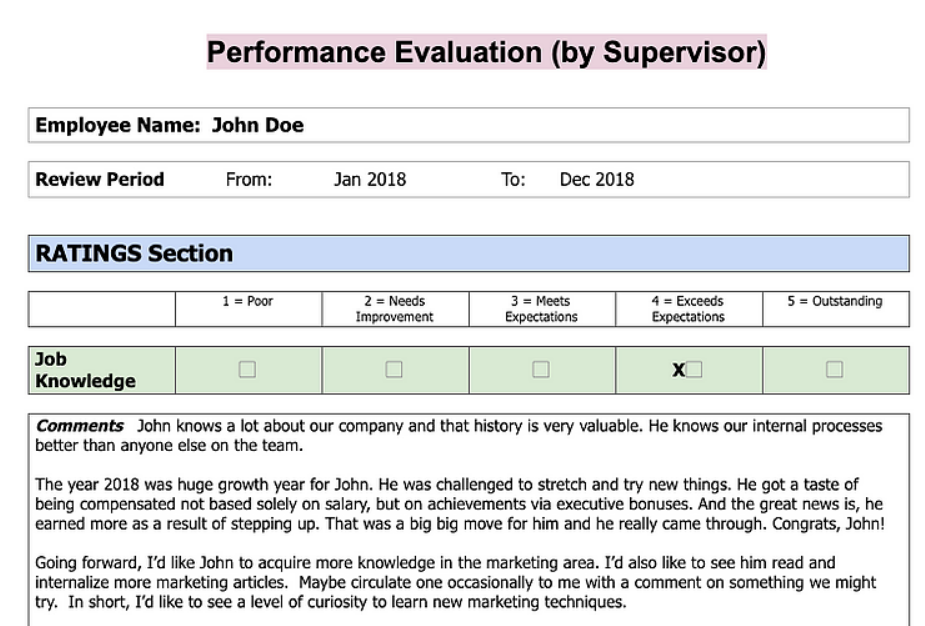How to Write and Deliver a Performance Review (With Example Templates)
The performance review. Dreaded equally, in some cases, by the giver and the receiver, but it doesn’t (and shouldn’t) have to be that way. If you’ve never written or delivered a performance review to an employee, or if the thought of doing a review is about as appealing as a root canal, here are a few tips to help you.
In recent years, the annual or semi-annual performance review process has come under a lot of fire. A 2018 article in Forbes magazine said they were pointless and insulting and referred to them as ‘artifacts leftover from the Industrial Revolution.’ Others contend that the written form is still vital because it puts structure into performance evaluations. Taking the time to write an evaluation signals to employees that you think they’re important. A performance review’s goal shouldn’t be to punish an employee for not meeting expectations but to help the employee and the business grow and succeed.
Keep This in Mind Before Writing a Performance Review
Research has found that performance feedback that only occurs a few times a year is unlikely to be meaningful. Providing ongoing, less formal communication consistently throughout the year, followed by a formal written performance review reflecting what employees have heard throughout the year, can be affirming and motivating.
A Gallup poll shows that when managers provide weekly (vs. annual) feedback, team members are: – 5.2 x more likely to strongly agree that they receive meaningful feedback – 3.2 x more likely to strongly agree they are motivated to do outstanding work – 2.7 x more likely to be engaged at work
Follow these steps to deliver a meaningful performance review:
1. Provide regular feedback throughout the year
Offering feedback and coaching (if necessary) regularly throughout the year will help you establish a solid foundation. Here are some guidelines for giving feedback:
Stick to verbal input most of the time. Sharing information feedback will be less intimidating and make employees more receptive. Don’t make it a big production.
Focus on positive rather than negative feedback. Think of the adage: you can catch more flies with honey than vinegar. This is not to say that you have to lavish praise for every effort; however, positive reinforcement is much more effective at encouraging employees to do good work.
Offer training rather than delivering after-the-fact critiquing. There’s always room to learn and grow, no matter what level of experience or how many years an employee’s been on the job.
2. Ask the employee to write a self-evaluation
Much like the formal review concept, the idea of employee self-evaluations has also received its share of criticism. A Harvard Business Review article advocates ditching an official form and instead, asking employees to prepare an informal list of their most important accomplishments and achievements. Again, others prefer having employees submit a formal evaluation (example here) that follows a form. The benefits of self-evaluation can be powerful by:
– Increasing an employee’s self-awareness – Reminding the reviewer of an employee’s accomplishments – Instilling self-confidence in an employee
3. Write & deliver the employee performance review
Using a performance review template (or developing your own, an example is here to get you started) and taking the employee’s self-assessment into account, complete your own review of the employee. While it’s advantageous to emphasize the positives, you should also be honest. A few tips: – Include a mix of numeric and qualitative feedback. (In the example linked to above, there is both a numerical rating of virtues such as “taking initiative” and a comments section to add color) – Don’t make it too long. Don’t view the performance review as a laundry list. Instead, focus on a few key areas where you think the employee has the most to celebrate and the most opportunity for improvement. – Deliver the review in person (or video call if in person isn’t possible). Don’t just email the review to your employee, instead schedule some time to review it together with them. This allows you to explain the context behind your thoughts and allows them to ask clarifying questions.
Click to Open Template of Example Supervisor Evaluation
Performance reviews can, and should, be a positive and beneficial experience for everyone if done correctly. They can also be a powerful tool that can enhance your relationship with employees and improve your organization’s performance.
Source: EO Global Octane Blog


